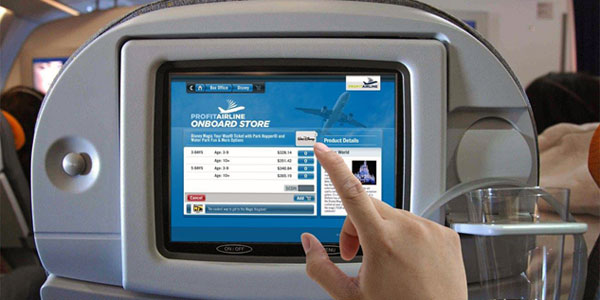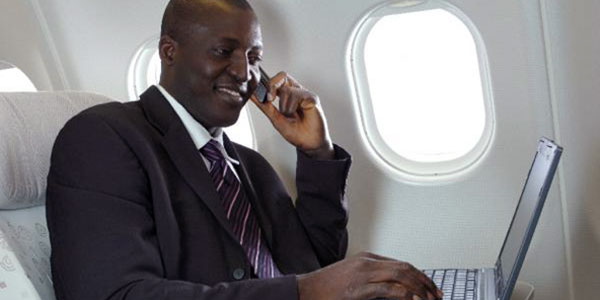
The growing emergence of game-changing, new connectivity technologies such as in-flight mobile networks and Wi-Fi services – and their increasing visibility in the air – is leading airlines across the globe to explore just what is possible in terms of the commercial diversions and retail opportunities that bring the flight alive for passengers.
Innovations in tablet and smartphone technology are being leveraged by airlines as a means of driving ancillary revenues, and are also the key to a more enticing passenger experience onboard, facilitating an ‘I want what I want, when I want it’ cabin environment, with instantaneous services and ever-evolving offers in IFE, duty free and food & beverage. The future of in-flight commercial will see the passenger gaining more independence too, as touch-sensitive seatback screens with connectivity capabilities begin to enable self-service shopping and food ordering, while airline staples such as the duty free cart and seat-pocket catalogue are being digitally reimagined. And according to some of the industry’s experts, the future of airline commercial has even more to offer, as the experience grows increasingly immersive and the passenger takes control.
In-flight self-service
Brett Proud, CEO of in-flight transaction specialist GuestLogix, who will take part in a conference session alongside speakers from Allegiant Air and Mastercard in the FTE ‘Up in the Air’ conference, explained that traveller independence is becoming as important a part of the passenger experience in the air as it is on the ground. “The trend is definitely moving towards passenger self-service onboard, be it buying through a seatback screen or via the passenger’s own device,” he said. “A plane is a highly public space – there’s people all around you so you don’t have an awful lot of privacy when paying. Or perhaps you had a snooze for two hours and woke up to find that while you were sleeping the duty free trolley went by and you missed your opportunity. With the proliferation of e-commerce, retail is now all about self-service – it is understandable that passengers have come to expect self-service in the air.”
Rather than being prompted by a crew member with a trolley, passengers are increasingly able to make their own choices on what they want to buy and when, by digitally selecting it at their own convenience. This development benefits airlines too – the virtual in-flight duty free store is open for the entire flight, and already, Proud explained, aircraft that offer self-service shopping have seen the number of onboard duty free sales increase by three to five times.
“I believe that, in relation to duty free, flight attendants will soon only be there for fulfilment. A passenger’s order will appear on a screen: ‘Please take this Mont Blanc pen to Seat 3D’ and the item will already be paid for – the only part a flight attendant will play is to fulfil the order onboard. And of course airlines more and more want to sell onboard for home delivery and for airport pick-up, so we’ll see those models emerging more too.”
In-flight connectivity

The pivotal driver behind this enhanced experience onboard is in-flight connectivity, with any number of opportunities for airlines to enhance services and generate revenue being made possible by GSM and high-speed Wi-Fi services at 35,000 feet. Internet and cellular services for passengers are just one aspect of the expanding portfolio of products for sale.
In-flight Wi-Fi provider OnAir has facilitated more than 40 airlines’ fleets with mobile GSM services and Wi-Fi hotspots. It has recently partnered with satellite operator Immarsat in the launch of its new Global Express Satellite, which will pioneer the faster and more efficient next generation of Internet in the air. OnAir CCO Stephan Egli said: “It will be in operation on a truly global scale as of 2015, and OnAir has signed to be the distributor for the new satellite in the aviation space, giving in-flight internet speeds similar to those on the ground and making it less expensive for carriers. When Wi-Fi is cheaper for airlines they will begin doing things that they couldn’t when costs were more prohibitive – new things will be happening in the next few years that we haven’t yet dreamed of.”
Faster connections could mean video streaming of live news bulletins or sports games in the cabin become the standard – on personal devices as well as on in-seat IFE systems – and streaming of radio too could become commonplace. Egli also suggested that passengers will no longer pay based on consumption of connectivity as at present is the norm, but instead will pay a fixed fee to log on, or even see the service become free of charge as onboard advertising sales become a new source of income for airlines. “The time when we’re flying on aircraft on which we can’t get a connection will be gone relatively soon,” he added.
In-flight innovation
With airlines and airports increasingly modelling themselves on retailers, shopping has become an even more embedded part of the air travel experience. Creative solutions developer Avanade is making exciting advances in next generation retail with the development of its Grab and Go wall concept which, in the future, could revolutionise retail both on the ground and in the air. The Grab and Go interactive kiosk, responds to gestures and touch-based interfaces to allow a customer to obtain information and coupons, and, though still in the early stages of implementation, it could enrich the shopping experience in the air from the ground, with enticing offers at kiosks in the terminal.
“You could have a large screen or video that features a rolling video of adverts, promotions or in-flight offers, for example. Then, using Kinect technology from Microsoft, the Grab and Go wall recognises when someone is in front of the screen and becomes interactive,” Steve Butcher, Avanade’s Senior Director Mobility and Embedded Group, Europe, Africa and Latin America, explained. “The user then makes gestures of grabbing information, coupons for example, or offers they want to retain for later, and places them into a ‘basket’ on screen.” When a user scans the on-screen QR code using their phone, or taps the NFC panel, a connection is made that stores that information on their own device so that they can take it away with them – into the air.
Avanade is currently in the process of developing its mobile POS for in-flight, and when the technologies become integrated into the air travel environment, products and offers can be seen on ground, recorded on a mobile, scanned and purchased in air.
In-flight personalisation
A key advantage of connected aircraft is that information can be relayed to and from the ground, and communicated to databases for analytics and business intelligence purposes. Payment systems that store information about the passenger’s purchasing preferences are increasingly enabling airlines to offer passengers a more targeted offer and in the future, Butcher explained, we may even see the advent of an in-flight retail experience that is personalised for every passenger.
“If I’m sitting in seat 5C, the airline will know what transactions have taken place there and will be able to link it to my passenger details,” he said, going on to explain that the ability to track the transactions of frequent flyers who buy a certain product every time they fly may eventually lead airlines to stock a product offering tailored to their personal preferences, taking in-flight individualisation to a whole new level.
GuestLogix’s Proud argued though that we are still some way away from finding our own personal, pre-filled shopping basket on a plane. “The level of sophistication needed to accomplish such a feat from a logistics and supply chain perspective is still a dream, but specialised offers delivered to me through an airline’s app are not. In fact, airlines are starting to do it now. At present I see apps as the best opportunity for personalisation for passengers. With in-built itinerary management, an app will know when you are in the duty free area, or waiting for your flight at the gate, and can use that information to put tailored offers in front of you.”
“If I had to paint a picture of what the experience will be like in the air in 2020, it would be that you will feel as though you’re on the ground. The bandwidth isn’t quite there yet but in ten years it’ll be pretty seamless and you’ll have everything you can have and do all that you can do on the ground,” Proud concluded.





